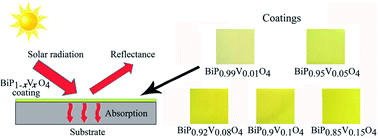Hydrothermal synthesis and characterization of novel yellow pigments based on V5+ doped BiPO4 with high near-infrared reflectance†
Abstract
In this study, a series of novel pigments based on V5+ doped BiPO4 have been prepared for the first time via a facile hydrothermal method and characterized using several analytical techniques, such as X-ray diffraction (XRD), field emission scanning electron microscopy (FE-SEM), ultraviolet-visible-near-infrared (UV-vis-NIR) spectrometry, the Commission International de l’Eclairage (CIE) L*a*b* color scales and thermogravimetry and differential thermal analysis (TG-DTA). The investigation demonstrated that the synthesized pigments of BiP1−xVxO4 (x = 0.00, 0.01, 0.05, 0.08, 0.10, 0.15) had a monazite-type phase structure and were about 0.25–2 μm in size. Meanwhile, the substitution of V5+ for P5+ in BiPO4 resulted in the band gap of the pigments varying from 3.657 to 3.244 eV and its mechanism was explained by charge-transfer and energy band theory, while the color changed from white to yellow. More importantly, the V5+ doped pigments possessed high NIR reflectance (>72%) and NIR solar reflectance (≥75.64%) in the range 700–2500 nm. Moreover, coatings colored with synthetic pigments have higher NIR solar reflectance (≥78.59%) than conventional pigments. Additionally, the pigments showed good thermal/chemical stabilities in high-temperature/acid/alkaline tests. In conclusion, the pigments have the potential to be applied as “cool pigments” to reduce energy consumption.



 Please wait while we load your content...
Please wait while we load your content...